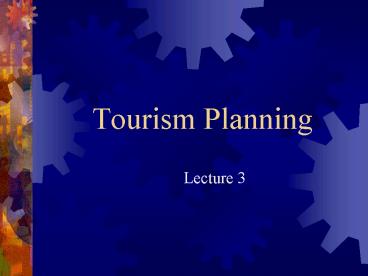Tourism Planning - PowerPoint PPT Presentation
1 / 15
Title:
Tourism Planning
Description:
Tourism Planning Lecture 3 What is tourism planning? In recent decades many places have turned to travel and tourism as a way to improve their economic and social ... – PowerPoint PPT presentation
Number of Views:2048
Avg rating:3.0/5.0
Title: Tourism Planning
1
Tourism Planning
- Lecture 3
2
What is tourism planning?
- In recent decades many places have turned to
travel and tourism as a way to improve their
economic and social conditions. - (examples developing countries encouraging
tourism) - Tourism in not an automatic cure for social and
economic conditions, and it can sometimes lead to
other problems itself.
3
What is tourism planning?
- There must be careful planning and consideration
of the costs and benefits of the tourism
activity/facility. - A tourism plan provides an overall vision social
and economic goals for the area that wants to
grow its tourism, and it provides a roadmap for
the years ahead.
4
Planning
- Murphy (1985) suggests
- Planning is concerned with anticipating and
regulating change in a system to promote orderly
development so as to increase the social,
economic and environmental benefits of the
development process. To do this, planning becomes
an ordered sequence of operations, designed to
lead to the achievement of either a single goal
or to a balance between several goals (p.156).
5
Tourism planning
- Spanoudis (1982) proposes that
- Tourism planning must always proceed within the
framework of an overall plan for the development
of an areas total resources and local
conditions and demands must be satisfied before
any other considerations are met (p.314).
6
The components of the tourism planning process
7
What is tourism planning?
Bad Planning Good Planning
Lead to overcrowding of local facilities Hurts the natural environment Commodification of local culture and loss of cultural identity Inflate local land values Increase prices of goods and services for local residents Increase employment Raises incomes and improves the quality of life Development of infrastructures Stimulate local business Increase government revenues Preserve cultural and natural resources Promote environmental protection
8
Who is involved in tourism planning?
- Developing the tourist potential for an area is
typically a joint effort between - PUBLIC SECTOR (various levels of Government)
- PRIVATE SECTOR (For-Profit Businesses and
Individuals)
9
What does the public sector do?
- The Role of the Public Sector is to make the area
desirable for the private sector to invest. This
includes - Constructing Workable Infrastructures
- (Transportation, water, sewage, parks)
- Providing Services
- (Education, health care, recreational)
- Promoting and Marketing the Region
- Providing Incentives
- - Financial (low interest loans)
- - Reduction in Costs (reduced tax on building
materials, lower land costs, risk-free marketing,
)
10
What does the private sector do?
- They base their tourism planning decisions on
what the tourists want and will buy - They could be a large-scale private business
(like a hotel chain) that is looking for new
areas to expand into, or it can be a small-scale
private business (bed breakfast)
11
What are the steps
- Ideally a tourism plan accomplishes the
following - What is the goal for increasing tourism , what is
the business situation past, present and
future, what is the market like - Prepare a Preliminary Plan
- Approval of plan by stakeholders
- Developing a final plan
- Completing the project
12
Means of achieving tourism planning
- Tourism planning reveals that it operates at
three levels - The site
- The destination
- The region.
- Tourism planning provide a set of guidelines for
the actions of - The government
- Private sector organizations, corporations,
businesses - Interest groups
- Host communities
13
In a commitment to the achievement of a
satisfactory tourism planning policy it is common
for sets of objectives to focus on the following
issues
- Economic
- - To optimize the contribution of tourism and
recreation to economic prosperity, full
employment, regional economic development, and
improved international balance of payments. - Socia-Cultural
- - To contribute to the personal growth and
education of the population and encourage their
appreciation of the local geography, history, and
ethnic diversity. - - To avoid encouraging activities that have the
potential to undermine or denigrate the social
and cultural values and resources of the area and
its traditions and lifestyles. - Market Development
- - To encourage the free entry of foreign
visitors, while balancing this goal with the need
to monitor persons and goods entering the country
with laws protecting public health.
14
Contd
- Resource Protection and Conservation
- - To protect and preserve the historical and
cultural foundations as a living part of
community life and development and to ensure
future generations an opportunity to enjoy the
rich heritage of the area. - - To ensure the compatibility of tourism,
recreational, and activity policies with other
broader interests in energy development and
conservation, environmental protection, and
judicious use of natural resources. - Human Resource Development
- - To ensure that tourism has an adequate supply
of professionally-trained skilled and managerial
staff to meet its future needs. - - To ensure that the education and training
programmes and materials are available to meet
the needs of tourism. - Government Operations
- - To coordinate government activities related to
tourism - - To take a leadership role
- - To support the needs of tourists, residents and
tourism businesses with appropriate legislation
and administration.
15
- Thank You































